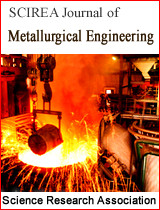Optical Surface Plasmon Resonance Monitoring in a High Salinity Environment for Long Duration Sensing Applications
DOI: 315 Downloads 3970 Views
Author(s)
Abstract
Optical sensing modes such as Surface Plasmon Resonance (SPR) are here applied to the detection surface induced processes and surface corrosion. Our recent studies have investigated the noble metals: silver, copper and gold. We present here results for silver sputter deposited films, with a sputter deposited chromium adhesion layer for exposure to a corrosive environment of standard saline solution over two months. Initial sensor design was achieved using a formalism of Fresnel’s optical equations for a uniaxial multi-layered media. Changes in metal film optical properties were measured using the Kretchmann-Raether experimental optical configuration. The study found that after films were exposed to standard saline solution, their reflectivity and relative permittivity changed, detectable as a shift in the minimum angle and shape of a SPR reflectivity curve whilst the thickness of the silver film was uncorroded.
Keywords
Metal Corrosion, Surface Plasmon Resonance, Permittivity Changes
Cite this paper
Christopher Lavers, Alistair Cree, David Jenkins, Nasih Salah, Matthew Findlay, Ian Hooper,
Optical Surface Plasmon Resonance Monitoring in a High Salinity Environment for Long Duration Sensing Applications
, SCIREA Journal of Metallurgical Engineering.
Volume 3, Issue 1, February 2018 | PP. 1-12.
References
| [ 1 ] | NACE (2002). Corrosion Costs and Preventive Stratergies in the United States. [Online] Available at: HYPERLINK "http://www.nace.org/uploadedFiles/Publications/ccsupp.pdf" http://www.nace.org/uploadedFiles/Publications/ccsupp.pdf [Accessed 23 March 2015]. |
| [ 2 ] | X Qi, & V Gelling, (2011). A Review of Different Sensors Applied to Corrosion Detection and Monitoring. Recent Patents on Corrosion Science, 1(1), pp.1-7. |
| [ 3 ] | A Himour, et al. (2005). Optical-fiber corrosion sensor based on deposit of Au/Ni-P. Japanese Journal of Applied Physics, 44(1), pp.305-10. |
| [ 4 ] | CR Lavers et. al., (2016), Optical SPR Sensor for Corrosion Patent Applications, British Patent Application No. 1611929.9, in the name of University of Plymouth SPR Sensor. |
| [ 5 ] | RW Wood, (1902). On a remarkable case of uneven distribution of light in a diffraction grating spectrum. Philysophical magazine, 4, pp.310-17. |
| [ 6 ] | A Otto, Excitation of non-radiative surface plasma waves in silver by the method of frustrated total reflection. Z Phys 216: 398-410; (1968). |
| [ 7 ] | E Kretschmann, (1968). Radiative decay of nonradiative surface plasmon excited by light. Z.Naturf., 23(A), pp.2135-36. |
| [ 8 ] | CR Lavers, (1993), The theoretical design and fabrication of a prism-coupled polarization conversion ferroelectric liquid crystal light modulator, Thin Solid Films, 230 217-224. |
| [ 9 ] | CR Lavers, D Jenkins, A Cree, N Salah, M Findlay, Recent Advances in Optical SPR Sensors for Corrosion Applications, Proceedings of Sensors and Their Applications XVIII, QMUL London, October 2016, to be published, IOP Publishing. |
| [ 10 ] | JC Maxwell-Grant, Phil. Trans. Roy. Soc., A203 (1904), 385 - 420. |
| [ 11 ] | DYK Ko and JR Sambles, J. Opt., Am., 5 (1988) 1863. |
| [ 12 ] | DW Berreman and TJ Scheffer, Phys Rev., Lett., 25 (1970, 577). |
| [ 13 ] | RMA Azzam and NM Bashara, Ellipsometry and Polarised Light, North-Holland, Amsterdam, 1986. |
| [ 14 ] | S Adachi, The Handbook on optical constants of metals, ISBN: 978-981-4405-94-2 (hardcover), World Scientific, 2012. |
| [ 15 ] | U Jönsson, L Fägerstam, B Ivarsson, B Johnsson, R Karlsson, K Lundh, S Löfås, B Persson, H Roos, I Rönnberg, et al., Real-time biospecific interaction analysis using surface plasmon resonance and a sensor chip technology, Biotechniques. 1991 Nov, 11(5):620-7. |
| [ 16 ] | B Johnsson, S Löfås, G Lindquist, Immobilization of proteins to a carboxymethyldextran-modified gold surface for biospecific interaction analysis in surface plasmon resonance sensors, Anal. Biochem. 1991 Nov 1; 198(2):268-77. |
| [ 17 ] | E Stenberg, B Persson, H Roos, C Urbaniczky, Quantitative determination of surface concentration of protein with surface plasmon resonance using radio-labeled proteins., J. Colloid Interface Sci. 1991;143:513–526. |
| [ 18 ] | J Chon, & K Iniewski, (2014). Nanoplasmonics: Advanced Device Applications. Washington: Taylor Francis Group. |
| [ 19 ] | JR Sambles, JD Pollard, GW Bradberry, Surface Plasmon Measurement of the Bonding Potential between an Organic Fluid and a Gold Film, Journal of Modern Optics, Volume 37, pp. 841-846, 1990. |
| [ 20 ] | NH Salah, Surface Plasmon Resonance Sensing and Characterisation of Nano-Colloids for Nanotoxicology Applications, thesis School of Computing, Electronics and Mathematics, Faculty of Science and Engineering, Plymouth University August 2015. |
| [ 21 ] | J Vitko Jr, RE Benner, JE Shelby, Corrosion of thin silver films in an aqueous environment, Solar Energy Materials, Volume 9, Issue 1, May 1983 / June 1983, pp. 51-67. |

